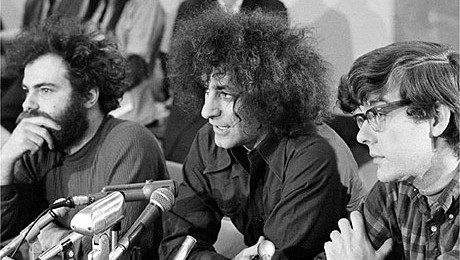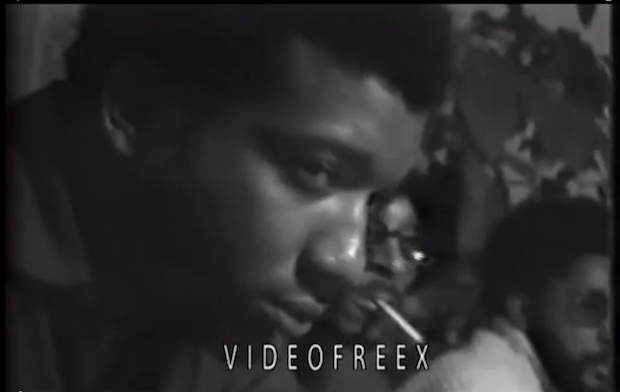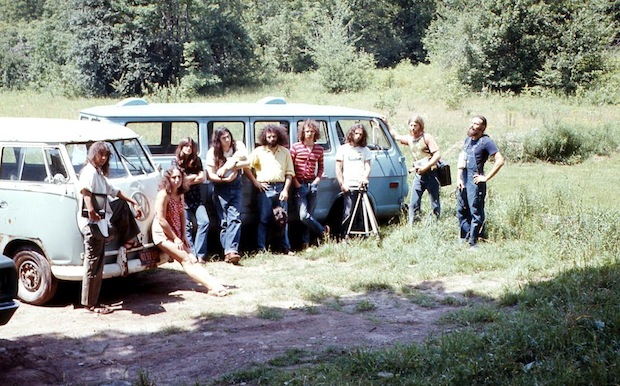The power of portable video can not be understated. At the time that the first Portapack, a small, handheld battery-powered video camera, was released in 1967, most people had only three major commercial networks, and early cable was confined to major cities. Getting on TV was only for actors and newsmen, companies decided what the public would view, and nobody said “fuck.” So for early video collectives like the Videofreex, the consumer camera was a tool for complete social upheaval—reflected in names like Raindance’s publication “Radical Software” and the “video revolution.”
“No one had [the Portapack] except for, perhaps, Nam June Paik,” Videofreex member Nancy Cain told me recently. “When it was put in my hands, I felt like I was one of the first hundred people to get going on it.”
The collective of early adopters convened around the Woodstock Music Festival, shooting everything the media didn’t cover: the acid trips, the anti-government grumblings, the long lines for the toilet. By 1969, their raw footage got the group notice at CBS. The television network commissioned them to shoot a documentary program on the youth movement.
The pilot episode “Subject to Change”—which contained interviews with Yippie activist Abbie Hoffman and Black Panther leader Fred Hampton—never aired, but in 1971, the group went on to found the country’s first pirate TV station in Lanesville, New York. The station operated until 1977. At a time when most towns had no more than a few TV stations, and before the explosion of hyper-specialized niche forums on the Internet, “Lanesville TV” was a rare experiment in what a centralized community media might look like.
Videofreex members Skip Blumberg and Nancy Cain will appear on Friday, October 10 at Philadelphia’s AUX Performance Space for a screening of their never-aired CBS pilot, video art, and clips from Lanesville TV.
How did you start working together? And why do you think CBS was interested in the Videofreex for a show?
Nancy Cain: I was working for Don West at CBS…we had a concept of putting together some sort of “real life” television, not the kind of television that you would generally see in 1969. There were really just three channels; nothing much. We were supposed to present this new fantastical idea about documentary television to the network, and we had no idea what we were going to do—and then we met the Videofreex, who had just come back from Woodstock.
Skip Blumberg: I think the guy in the mailroom at CBS told Nancy about the Videofreex, who told the executive producer of the show. And that’s how the Freex were found.
Nancy Cain: David and Curtis went to the Woodstock Festival, where they met Parry, who had a very old Panasonic, I don’t even think he had sound. He’d set it up at the festival to show people how they might look on television. They’d see the TV monitor, and they’d see themselves—wow! And they would stand in line to see this!
The most interesting thing to me about the footage that they showed were these miles-long lines of people waiting for the Port-a-Potties. It was the exact, reverse angle of anything that was shown in mainstream media…I couldn’t take my eyes off it! I realized then that everywhere networks are pointing their camera, we want to be looking the other way. I think that’s what made it all so exciting.
Skip Blumberg: After that, the Videofreex more or less took over and got most of the funding for production, and Don really liked that. I was hired to help, as well as Carol and Nancy, to get the show ready.
How did you get access to people like [Yippie activist] Abbie Hoffman and [Black Panther leader] Fred Hampton for interviews?
Nancy Cain: David had gone to Brandeis University with Abbie Hoffman. The day that I met David at the Videofreex loft, he said his friend Abbie Hoffman was going to be a defendant at this trial, the “Chicago Eight”—they called it “The Trial of the Century.” So we immediately got Don West to say, “Yes, go out and cover that.” He gave us his family car and sent us off to the war.
Skip Blumberg: See, your college contacts do pay off! [Laughs] Abbie showed David a lot of trust and said things to him because he knew David. The interview was very informal and very honest and outspoken. In those days, nobody said the work “Fuck” on TV. Never. And so, when David asked, “Do you want to say something?” Abbie said “FUCK!”
Nancy Cain: That was kind of like the starting gun for us.
Skip Blumberg: And [Black Panther leader] Fred Hampton was a contact that was made there, through, I believe, one of the [Black Panther’s] benefactors.
[Ed note: Their reel “The Videofreex Pirate TV Show” includes an interview with Hampton in September 1969, two months before he was assassinated. The Videofreex ask him about whether or not he’s afraid of being attacked, and whether the party can continue if he were. Hampton said he wasn’t worried because “We don’t produce buffoons, we produce leaders.”. He thought that the government might initiate programs that would start protecting civil rights leaders.]
Skip Blumberg: But you have to know, the CBS pilot was our first production. We’d had no experience making a TV show before [laughs]. Zero, none! Not shooting, not editing…Nancy had some experience before me, I think, on television as a performer. Other people were artists; Bart was in the music industry. So it’s no surprise that CBS thought our show wasn’t worthy of putting on their network.
Nancy Cain: Well, they were a buncha slobs anyway.
Skip Blumberg: It’s ironic that we got together, to a large extent, for that [network TV] pilot.
And you went on to shoot things like mass protests…the “Videofreex Pirate TV Show” reel includes footage from jail…
[The Videofreex joined many other collectives to form the “May Day Video Collective”, which documented the 1971 May Day protests against the Vietnam War in Washington, DC. The New York Times reported that 7,000 people were arrested during this particular protest].
Nancy Cain: The hippies wanted to shut down the government, basically, while Nixon was president. We found out about it through the media school at Antioch College. The Videofreex went to Washington, DC, as its own collective, but the protest had all the factions: anti-war, women’s rights, men in dresses…everything that was not going to be allowed.
So [the protesters] stopped traffic and closed down a few bridges into the city. Nixon even had to get on the air and say that “They have not closed down the government, we’re not going to let them do anything, we’re still in control, don’t worry.” Police were gassing and trashing us. That’s very radicalizing, to be gassed. To be a protestor and get gassed for the first time really changes your perspective about yourself and your government.
So when you were showing these early tapes in the late sixties and early seventies, you would just invite people to the Videofreex studio?
Nancy Cain: Yes, every Friday night, we’d have shows. So we’d just be shooting, shooting, shooting, and people would swarm in on Friday nights…
Skip Blumberg: By “swarming in,” Nancy means from like five to a hundred and fifty people.
Nancy Cain: That’s a lot!
Skip Blumberg: Well, they were unadvertised, but after we were in the New Yorker Magazine, in “Talk of the Town,” we had a hundred and fifty people. There were articles in Newsweek and Rolling Stone Magazine about indie video, but most people hadn’t experienced it. Because it was only in lofts and out-of-the way places.
We would rack up a few different tapes that we’d shot that week, that we’d shot in the staircase that afternoon, video art, tapes that our friends Dean and Dudley sent to us from their travels in a van they dubbed “the Fobile Muck Truck”, which was like a travelling production unit that they had…and we had a switcher, we would just cut, cut, cut. In those days we had a longer tolerance for longer tapes, so we would leave things on for a while, or put on music or something. It was a spontaneous mash-up that we would have on Friday nights, very experimental.
So when you went to Lanesville [in 1971] to found the pirate TV station, how did you explain your intentions to people?
Nancy Cain: Well, we painted our mailbox with the word “VIDEO” on it [laughs]. I think it was the children in the neighborhood who were turned on to us more quickly, and then we met their parents and their families.
Skip Blumberg: People were wary of us because culturally, we were much different. A lot of the people in that valley were lower middle-class country people, and we were these long-haired city people who came up.
The first thing we did was put an antenna up on our mountain to receive TV signals better, so we had a little cable TV network. When we started transmitting, we would cover local events: the Benjamin Family Birthday Party, or the kayak races. We made mockumentaries, like one about a UFO landing in Lanesville. We chromakeyed, or lumakeyed, our dummy UFO into the valley, and then we had our neighbors commenting about what they saw. So there was a man on his tractor talking about this “big flat piece of material” he saw in the sky [laughs]. [Scroll to 18:00 in the above video].
We covered “The Farkle-VanFight.” These two guys, Frankie Farkle and Rocky Van, were gonna fight each other, and they said, “Let’s make this a fundraiser.” It was for the local rescue squad.
Yes, I love all the pre-interviews and the gearing-up shots that you have leading up to what was basically a local bar fight. [The episode leads up to the match with interviews with the fighters’ neighbors, mothers, friends, and bartender].
Skip Blumberg: It was great, because it drew a huge crowd. We broadcasted it live from the local bar, and we would put their picture on the TV monitor in the bar. There would be a hundred people in the bar on a Tuesday night, which would normally only get three people. And so everybody loved us for that, too, and suddenly they were on television!
Nancy Cain: The great thing about Lanesville is it had easy access to the New York State Thruway. And we went everywhere along those roads, Rochester, Ithaca, Buffalo, Syracuse…we went to all the libraries, art museums, galleries, the New York State Historical Association…
And then we would teach these people how to make their own TV in their own communities. We would go with them to the cable company, and explain to the company that it was part of their contract that they had to give access to the community in order for them to cable up in their town. [Ed note: This is the founding principal of public access TV stations, that cable companies have to give a portion of their revenues to public access programming and studios. According to their website, the Videofreex Media Center was supported by NEA, NYSCA, and contracts with educational agencies and early public access stations.]
They didn’t like that at all. They certainly didn’t want to give a channel to a bunch of…people. But they had to, it was a term for their contract that they weren’t really expecting to have to fulfill. There were times when there were pounding of fists and jumping on tables. There was one time I looked at this guy and I thought, I am going to grab his tie, and I am going to pull it. I didn’t do it, but that was the feeling at these meetings!
Skip Blumberg: At the time, there had been only one channel in that valley; that was channel two, and we were channel three. Sometimes, our channel three would drift into channel two. One time, I remember one of our neighbors, Gertie, called in to complain that we were interrupting her All in The Family. So we paused our broadcast so she could finish watching her show.
We surveyed people about their TV reception, what they wanted from local programming. We would have the telephone on and people would call us, and we would put their voices on our shows. We would also broadcast discussions about radical politics after our show—to us, this was just a continuation of the program.
But the people who watched often became a very sophisticated audience. This was really valuable to us for a number of reasons, one is we were able to explore with the most powerful part of television which is live broadcasting. Now you can stream live, but in those days that was restricted to just people with millions of dollars of equipment, and a studio.
It also got us to know what an audience was like, to be talking to a distant audience that wasn’t there. And we started to get a sense of what it was like to feel an audience. To know that you’re communicating.
How did that change your programming, getting feedback like that?
Nancy Cain: It informed the programming in so many ways. We were watching them, they were watching us. If there was an event happening, we would cover it. It was like we were all in it together.
Skip Blumberg: In that era, everything was so collaborative. There was a real openness, in general, with the people in Lanesville, with anybody who came up to visit us. Maple Tree Farm [the Videofreex media center] was a 17-bedroom house, we had a lot of guest rooms. There were about ten main Videofreex but maybe fifty others who passed through at some time as a member of the group…other video artists would come up and make work, we would travel with Raindance.
How did it all end?
Skip Blumberg: Eventually, everybody left to do something else. Career interests, being an individual artist…I fell in love. Finally, at the end, it was Nancy and Bart and Chuck. They all went on to do other work in publishing, the TV industry. I made independent productions about culture, and did work for Sesame Street and National Geographic TV.
Nancy Cain: And we went on from Lanesville to Woodstock, and continued the media center there. And then I moved to California and made it big in Hollywood. I ended up working for shows along the lines of The Real World…not that, but similar shows. As a field director or producer, you can always get jobs on these kinds of things. Oh, “reality TV”? No problem! But then it turned into something else entirely.
But the wonderful thing about that time with Videofreex, was that there was no such thing as “Take One, Take Two”—it was just a continuum. It was my ticket to life and adventure! Having that little camera was the greatest thing that ever happened to me.






Comments on this entry are closed.